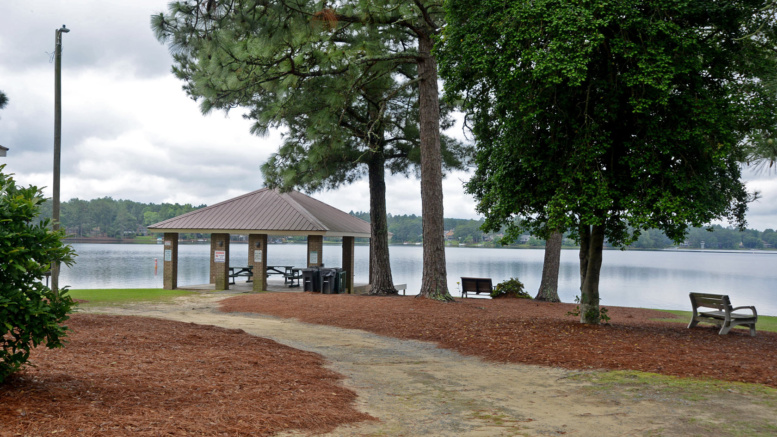By Maggie Beamguard
Insider Editor
This story has been updated to clarify that the coffer dam and four to six month permit process is for the Sequoia Lake bottom drain.
The Seven Lakes Landowners Association has received a $250,000 state grant for dam safety improvements.
Verbal confirmation of the grant approval came a week prior to its public announcement at the Sept. 12 SLLA board meeting. The funds were deposited into an SLLA account on Friday, Sept. 13.
The funds release a little financial pressure from the community, which had anticipated a costly, state-mandated bottom drain construction project for Lake Sequoia.
The grant was secured by the efforts of the Sequoia Bottom Drain Funding Ad Hoc Committee composed of SLLA Board President and Committee Chair Heather Guild, Mike Freidel, Conrad Meyer and Bruce Runyan. They worked with JT Grimes, the dam engineer consultant.
The committee has been working with state Sen. Tom McInnis, whose district includes Moore County, since last November to identify possible funding to help out with the bottom drain, submitting a proposal to him for consideration in the 2025/2026 state budget.
Guild expects the SLLA will hear back about their budget proposal in the second quarter of 2025 as the state prepares the budget. In the meantime, McInnis identified a grant to provide an additional source of funds.
“We got notification in May that Sen. McInnis was able to identify an opportunity for us to get a direct grant of $250,000 from the North Carolina Office of State Budget and Management, provided we were able to pass all the thresholds of the application process,” said Guild. “So the grant was out there. It was earmarked for us. But we still had to go through an application process and submit that application, and then find out if it was actually going to come through for us.”
The one-time grant to the SLLA is specifically for capital costs and equipment associated with dam safety improvements. The monies are not specified for the Sequoia bottom drain project, but can be used for any capital costs associated with any dam safety improvements. The grant requires the SLLA to provide validation with receipts on how the funds are spent.
“The reality is, I think a majority of it will go for (the Sequoia dam project), but we do have one repair that we were currently looking at doing before this came through. Some of those funds might be allocated to that repair,” said Guild.
This repair concerns issues identified with the toe drain on the Lake Juniper dam. Toe drains help control seepage from earthen dams.
“Clearly we want to repair those so that we get everything running 100 percent, not 80 percent,” said Guild. “So that’s likely what some of those funds will be used for, because it’s very much spot-on with what the state said they wanted with capital costs and equipment associated with dam safety.”
By staying on top of maintenance repairs, the SLLA hopes to avoid the development of any more serious safety issues in the future.
The committee also investigated a grant from the Federal Emergency Management Agency for privately owned high hazard dams.
“The good news for us is that our dam is in too good of shape and we didn’t qualify for that one,” said Guild.
The SLLA maintains seven earthen dams, five of which are considered high hazard dams. Guild said they strive to meet the highest possible standards for dam maintenance from both the state and federal level.
Lake Sequoia was constructed in 1974, four years prior to a statute requiring a bottom drain. In 2019, the SLLA was informed by the NC Department of Environmental Quality that a bottom drain would be required.
Retrofitting a bottom drain presented a huge financial challenge. Initially estimated to cost around $900,000, the estimate is now closer to $2.3 million. The SLLA has been budgeting for this capital expenditure since 2019, demonstrating to the NCDEQ that it is continuing to move forward in good faith. The dams are in good shape and have passed every inspection.
“We’ve never assumed we would get money from the state,” said Guild. “We’ve always assumed that we would have to self-fund this.”
In anticipation of the project, the board has been building up the restricted reserves by $200,000 to $300,000 a year. One of three reserve accounts, “restricted reserves,” may only be used for road construction and state-mandated dam repairs. These restricted funds apply to the state-mandated bottom drain for Lake Sequoia, but not for the routine maintenance of the toe drain at Lake Juniper.
“Sen. McInnis is trying to help us with that because he understands the goal post moved and nobody told us the goal post moved and now we have a huge financial challenge to try to do what the state is now making us do,” said Guild. “I think he has a keen sense of, yes, obviously keeping the dams safe and in good repair and all of that is beneficial to the community on this side of the dam. But it’s also very beneficial to the community on the other side of the dam whether it’s the houses or state and county infrastructure that lies on the other side. He sees it as a kind of symbiotic relationship that actually serves everybody well.
“We are very appreciative.”
McInnis could not be reached for comment on the issue.
The association is in the beginning phase of the toe-drain repair on Lake Juniper, which starts with engineering drawings and a permit application to the state.
Meanwhile, the application for the construction of the Sequoia bottom drain was filed with NCDEQ in late summer. Guild has been told to expect the review process to take anywhere from four to six months. Once approval is granted, the construction project would be put out to bid. The time frame construction is dependent on many factors.
A temporary structure, a cofferdam, will be built around the construction area that goes down to the bottom of the lake. Water is drained from the cofferdam, creating a dry area for construction. The lake will remain operational once construction begins.
A cofferdam is a temporary watertight enclosure that is built around a body of water to allow construction or repair work to be done in a dry environment.
Guild is pleased the grant came through.
“I think it’s very good news, obviously, for us. I think it’s good news for the community at large” she said. “Thank you very much, North Carolina, and we will do our very best to get the job done right.”
Contact Maggie Beamguard at maggie@thepilot.com.







